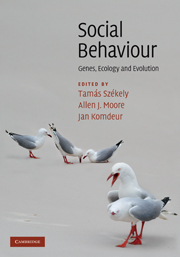Book contents
- Frontmatter
- Contents
- List of contributors
- Introduction: The uphill climb of sociobiology: towards a new synthesis
- Profile: Undiminished passion
- Part I Foundations
- 1 Nature–nurture interactions
- Profile: Social evolution, sexual intrigue and serendipity
- 2 The quantitative genetics of social behaviour
- Profile: Mating systems: integrating sexual conflict and ecology
- 3 Social behaviour and bird song from a neural and endocrine perspective
- Profile: In love with Ropalidia marginata: 34 years, and still going strong
- 4 Evolutionary game theory
- Profile: The huddler's dilemma: a cold shoulder or a warm inner glow
- 5 Recent advances in comparative methods
- Profile: Multi-component signals in ant communication
- 6 Social evolution theory: a review of methods and approaches
- Profile: What's wrong with this picture?
- Part II Themes
- Part III Implications
- Species index
- Subject index
- References
1 - Nature–nurture interactions
Published online by Cambridge University Press: 05 June 2012
- Frontmatter
- Contents
- List of contributors
- Introduction: The uphill climb of sociobiology: towards a new synthesis
- Profile: Undiminished passion
- Part I Foundations
- 1 Nature–nurture interactions
- Profile: Social evolution, sexual intrigue and serendipity
- 2 The quantitative genetics of social behaviour
- Profile: Mating systems: integrating sexual conflict and ecology
- 3 Social behaviour and bird song from a neural and endocrine perspective
- Profile: In love with Ropalidia marginata: 34 years, and still going strong
- 4 Evolutionary game theory
- Profile: The huddler's dilemma: a cold shoulder or a warm inner glow
- 5 Recent advances in comparative methods
- Profile: Multi-component signals in ant communication
- 6 Social evolution theory: a review of methods and approaches
- Profile: What's wrong with this picture?
- Part II Themes
- Part III Implications
- Species index
- Subject index
- References
Summary
Overview
Inheritance is associated with a paradox: it roars with the survival of the species, while at the same time it whispers a fragile message that is constantly modified even among kin. The genes, the environmental context and the traits that arise from their interaction are interrelated. A complexity that characterises this three-way relationship has been attributed to the nature–nurture dichotomy. Traditionally, nature is understood to mean the genes, whereas nurture denotes the environment. So, for example, people may debate why one pumpkin is superior to another – was it the quality of the soil or other growth conditions in the pumpkin patch, or was it the specific combination of alleles in that pumpkin's genome?
In recent years, there has been a long-overdue paradigm shift from a limited focus on the nature–nurture dichotomy to a more expansive view that includes gene by environment (G × E) interactions and even gene–environment (G ↔ E) interdependencies, as defined and discussed in this chapter (Rutter 2007). A mechanistic basis for the concept of interdependency arose from advances in molecular biology and genomics which show that DNA is not only inherited but is also environmentally responsive. The latter argument is supported by findings that individuals with dissimilarities in their DNA (DNA polymorphisms) are differentially affected by the same environment. Different environments through development and adulthood can affect individuals with one genetic variant but not another.
- Type
- Chapter
- Information
- Social BehaviourGenes, Ecology and Evolution, pp. 11 - 25Publisher: Cambridge University PressPrint publication year: 2010
References
- 11
- Cited by



